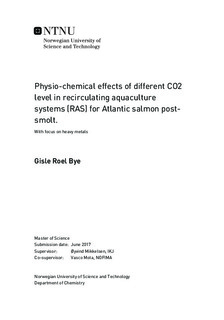Physio-chemical effects of different CO2 level in recirculating aquaculture systems (RAS) for Atlantic salmon post-smolt. - With focus on heavy metals
Master thesis
Permanent lenke
http://hdl.handle.net/11250/2447791Utgivelsesdato
2017Metadata
Vis full innførselSamlinger
- Institutt for kjemi [1404]
Sammendrag
In this master thesis, effects of different carbon dioxide (CO2) concentrations in a recirculating aquaculture system (RAS) have been studied, with focus in different effects on the different physio-chemical parameters and selected heavy metals. The changes in pH, redox potential, temperature, salinity, conductivity and turbidity have been studied. Other water quality parameters, such as water hardness and alkalinity is also discussed. The changes in the physio-chemical parameters affects heavy metals in water. In this thesis, 8 elements have been selected to be studied. The selected elements are Al, As, Cd, Cr, Cu, Fe, Mn, Ni and Zn. These were chosen because of interesting results, previous research in accumulation of heavy metals in RAS and because of possible toxic effects on the fish.
The sample collection was done in a period of 12 weeks, where 8 different sampling dates were conducted. Water samples was sent to an element analysis by the ICP-MS and analysis of Total organic carbon (TOC) performed by a combustion technique, using a NDIR detector. The results from the analysis was analysed by an analysis of variance (ANOVA), both by a one-way and a two-way analysis. The purpose of these analysis is to see if there is a statistically significant difference in the obtained values from the element analysis between the different treatments of CO2 throughout the experiment.
The results shows that iron has a statistical difference between the different CO2-treatments over time. None of the other elements showed a statistical difference over time. All of the elements had an increase in concentration through the experiment. The elements with the largest increase in concentration over time are Fe, Zn, As and Cd, while the other elements only had a small total increase in concentration.
Today the concentration limit of CO2 in RAS is debated. This master thesis is a small part of the CO2 RAS project, where the main goal is to determine the effect of dissolved CO2 (5-40 mg/l) in Atlantic salmon post-smolt (100 600g) performance, health and welfare in brackish water recirculating aquaculture systems (RAS).
